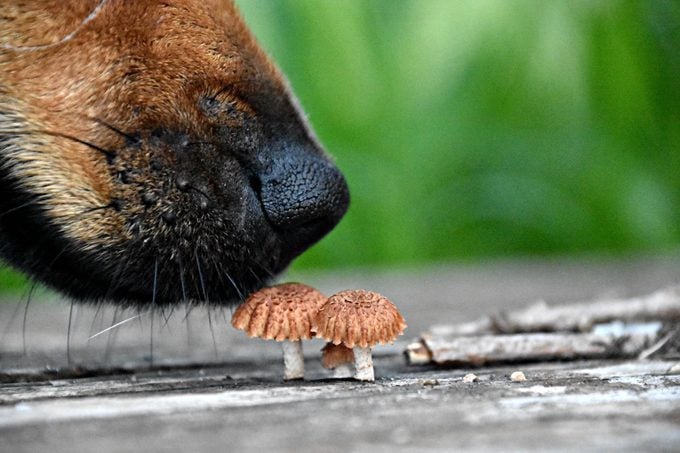Can Dogs Eat Mushrooms? Here’s What Experts Say
Updated: Jun. 21, 2021
Some mushrooms, especially wild mushrooms, can be toxic to dogs. Here's what you should know about the safety of mushrooms for your four-legged friends.
A fungus among us
Mushrooms can be nutritious, versatile foods, and they have played important roles in human diets for thousands of years.
So it’s only natural for some mushroom-loving dog parents to want to share their passion with their pets.
But are mushrooms safe for dogs to eat? And how much can the risk vary?
In short, the safety of mushrooms for dogs depends primarily on the kind of mushroom. Most culinary varieties of mushrooms are safe for dogs to eat in moderation, unless they are coated or cooked with foods dogs cannot eat.
But dogs should never eat wild mushrooms found outdoors since those could contain dangerous toxins. And even among mushrooms that are considered safe for dogs to eat, the downsides of actually feeding them to your dog may outweigh the benefits.
Here is what experts want you to know about dogs and mushrooms, including which types to avoid, how to identify mushroom poisoning in dogs, and how to seek treatment.
Why are some foods toxic to dogs?
Some foods are dangerous for dogs to eat because of choking or digestive hazards (like pits, cores, hard skins or spikes) or their fiber content. In most cases, however, mushrooms that are not safe for dogs to consume are unsafe because they contain toxins.
Different types of mushrooms produce different toxins that affect different organs or systems in the body.
Many fungal toxins found in mushrooms fall into one of the following categories:
- Hepatotoxic: harmful to the liver
- Neurotoxic: harmful to the brain or nervous system
- Gastrointestinal toxin: harmful to the digestive system
- Nephrotoxic: harmful to the kidneys
Can dogs eat the mushrooms we eat?
“Mushrooms that you find in a grocery store are not dangerous for your pet,” says Tina Wismer, DVM, senior director of the American Society for the Prevention of Cruelty to Animals (ASPCA) Animal Poison Control Center.
But while most culinary mushrooms are safe for dogs on their own, humans tend not to eat mushrooms raw or plain.
Many people cook their mushrooms with other foods and seasonings, some of which may be less safe or unsafe for dogs to consume, such as:
- butter
- cooking oils
- most seasonings
- garlic, leeks, or onions
- salt
Feeding mushrooms to dogs may also encourage dogs to seek out mushrooms in the wild, where they could encounter highly toxic species.
Experts say that for all these reasons, it is generally safest not to feed dogs mushrooms of any kind.
If you do, make sure to give them small quantities of well-cleaned, store-bought mushrooms, ideally those that have been cooked a bit to help make them easier to digest, says Barbara Hodges, DVM, director of advocacy and outreach for the Humane Society Veterinary Medical Association.

Can dogs eat wild mushrooms?
Wild mushrooms come in a wide array of colors, sizes, shapes, and textures. And sometimes even mycologists—experts who study fungi—have a hard time telling species apart.
The repercussions of eating the wrong species of mushroom can be deadly, so it’s crucial to know exactly what species you’re dealing with.
“Unless you are a mushrooms expert, it can be very difficult to identify wild mushrooms,” says Maggie Brown-Bury, DVM, the Newfoundland and Labrador representative on the Canadian Veterinary Medical Association council. “Toxic mushrooms are incredibly toxic, so it is best to assume all wild-growing mushrooms are dangerous.”
If your dog does eat a wild mushroom, or if you suspect it might have, experts say to always treat it as a veterinary emergency.
Wild mushroom species that are poisonous to dogs
According to the American Kennel Club (AKC), only around 50 to 100 of the 10,000 known mushroom species globally are toxic to dogs. But those species that are dangerous for dogs can be deadly if ingested, even in small portions.
“One mushroom, or in some cases one bite of mushroom, can be potentially dangerous or fatal,” Dr. Wismer says.
People who walk their dogs in places with wild mushrooms should try to familiarize themselves with species that can be a problem for their four-legged friends.
The types of mushrooms that present the most danger for dogs, and even the mushrooms’ appearance, can vary significantly by geographic region and climate, Dr. Hodges explains.
Still, some mushrooms tend to pose a greater risk than others. According to Dr. Wismer, the Merck Veterinary Manual, and other authoritative sources, the following species are among the most likely to cause a problem for dogs in North America.
Scleroderma mushrooms
“Stomach problems can arise after the consumption of certain mushroom types, such as Scleroderma,” Dr. Wismer says. “These mushrooms can cause mild to severe vomiting and diarrhea. Pets will usually start having problems within a few hours of ingestion.”
While mild vomiting or diarrhea may not be a major concern, Dr. Wismer says, dehydration and electrolyte imbalances are severe signs that require medical attention.
According to the North American Mycological Association, researchers still don’t know which toxin can be found in Scleroderma species. (There are about 25 different species of these types of mushrooms worldwide.) The toxins in Scleroderma species reportedly are not considered deadly to humans.
Scleroderma mushrooms look a bit like potatoes growing out of the ground. They are sometimes called potato earthballs. Unlike many other types of mushrooms that grow on stalks, Scleroderma mushrooms are round and light-colored with a dark interior and rootlike strands at the base.
Inocybe and Clitocybe mushrooms
The Inocybe species contains toxins that affect the parasympathetic nervous system, the internal system that helps control the body’s rest and digestive response, Dr. Wismer explains. Dogs that eat Inocybe mushrooms may experience vomiting, diarrhea, a decrease in heart rate, and severe drooling, she says.
Many Inocybe species are brown to bright rust, orange brown, or dull brown gray in color. Inocybe mushrooms also release a fishy odor that some dogs find attractive.
The Clitocybe mushroom species contains muscarine, the same toxin in mushrooms of the Inocybe species. Muscarine seems to cause severe reactions only in dogs, not humans. Clitocybe mushrooms tend to be white, and they are widespread in North America.
Psilocybe, aka magic mushrooms
In dogs, so-called magic mushrooms from the genus Psilocybe can cause unsteadiness on the feet, agitation, mild to severe depression, sensitivity to sound and touch, and tremors, Dr. Wismer explains.
“Pets may show vomiting and diarrhea as well with these mushrooms,” she says.
Many Psilocybe mushrooms are a dark purple brown to lilac brown. They can grow year round and are commonly found on the ground, in rotting wood, or in feces from species like cows or horses.
Amanita phalloides, aka death cap
One of the most infamous species of toxic mushrooms for dogs—and humans—is the “death cap,” or Amanita phalloides, Dr. Wismer says.
In dogs, symptoms may take anywhere from eight to 24 hours after ingestion to develop, she says, potentially leading some people to believe their dog does not require medical attention.
“When symptoms do start, they may include stomach upset, decrease in appetite and energy, yellowing of the eyes and skin, and ultimately liver failure and death,” Dr. Wismer says.
A. phalloides contains amatoxins, and it causes more human and animal deaths globally than any other mushroom, according to the Merck Veterinary Manual.
This family of mushrooms also contains a similar, highly toxic species called the Amanita gemmata, or the jeweled deathcap.
A. phalloides tends to be yellow green or greenish white in color and grows on the ground under hardwood trees, conifers, junipers, and oak trees.
Amanita muscaria and A. pantherina
Related to Amanita phalloides, these species contain the toxins muscimol and ibotenic acid, both of which can be safe for humans in moderate amounts.
In dogs, symptoms may not develop for six to 12 hours after ingestion, but the toxins can kill dogs in rare cases.
Symptoms of toxic exposure to A. muscaria and A. pantherina usually include sedation, seizures, unusual walking patterns, and tremors (muscle spasms). Vomiting or diarrhea may also occur.
Both A. muscaria and A. pantherina contain amatoxins and have a fishy odor some dogs may find intriguing. Yet these species do not tend to look much alike.
A. muscaria usually appears yellow, orange, or white to reddish tan and grows on the ground under pine, poplar, oak, spruce, and birch trees.
A. pantherina is usually white with patches or dark to yellow brown with white at the edges. It usually grows under conifer trees, particularly Douglas fir trees, and is rarely found in the Eastern United States.
Galerina marginate, aka deadly galerina
This species contains amatoxins that are also found in A. phalloides.
G. marginate tends to grow as small, clustering, brown to rust-brown mushrooms, with smooth, rounded caps and light-brown underbellies or gills. They often grow on wood chips and well-decayed rotting wood, and can be nearly impossible to tell apart from extremely common mushrooms like button mushrooms.
Why do dogs eat wild mushrooms?
Some people mistakenly believe dogs will avoid eating poisonous substances because of their scent. But this is not true.
According to the AKC, dogs explore their environment through taste and smell, and they may snarf up something they consider interesting—like a mushroom.
The unique texture and shape of mushrooms may interest dogs, and some toxic mushrooms even release distinctive odors that can appeal to some dogs.
Symptoms of mushroom poisoning in dogs
Different mushrooms contain different toxins that act on the body differently. So the symptoms a dog experiences after eating a toxic mushroom depend mostly on the type of mushroom.
A dog’s response to mushroom toxins can also vary depending on the dog’s general health, as well as what else the dog ate along with the mushroom.
Some wild mushrooms that are not toxic to dogs may still cause temporary digestive problems. Other mushrooms may cause fairly severe reactions that are not life threatening.
According to the AKC, signs and symptoms of mushroom poisoning in dogs include:
- severe vomiting and diarrhea
- increased salivation and drooling
- eye watering
- increased urination
- unexplained weakness or exhaustion
- staggering or “walking drunk”
- tremors
- seizures
- yellowing of the whites of the eyes and mucus membranes
- severe abdominal pain
- reduced heart rate
If the poisoning is severe or left untreated, a dog may go into a coma. Dogs, like people, can also die from mushroom poisoning.
What to do if a dog eats a wild mushroom
Most veterinary experts and animal-welfare organizations recommend always treating wild mushroom exposure or consumption as an emergency.
To seek care for a dog that may have eaten a wild mushroom or been exposed to one, contact your veterinarian or an emergency veterinary clinic, or call ASPCA Animal Poison Control at 888-426-4435.
Immediately take a dog with potential mushroom poisoning to the nearest veterinary clinic.
If possible and safe to do so, the AKC recommends collecting samples of the mushroom the dog may have eaten. Try to keep mushroom samples in a damp piece of paper towel inside a paper bag or wax paper, and refrigerate it as soon as possible. It is also a good idea to take photos of the mushroom in question and the area where it was growing.
Give the mushroom samples or pictures to a veterinary technician or veterinarian when seeking treatment. This important information might help identify the specific mushroom causing the problem.
Treatments for mushroom poisoning in dogs
The best treatment for a dog poisoned by mushrooms depends on the type of mushroom, how recently the mushroom was eaten, and a dog’s symptoms, according to the AKC.
If the poisoning was fairly recent, a veterinarian may give the dog medications that force it to regurgitate the toxic substances. If much time has passed, the dog may need to take medications that counteract the effects of the toxin.
A dog may also require monitoring and supportive treatments, such as fluids to manage side effects and symptoms after mushroom poisoning.
Where are wild mushrooms found?
Wild mushrooms can grow almost anywhere. After a night of heavy rain, mushrooms may sprout up very quickly—even overnight—in outdoor areas ranging from fields and forests to lawns and gardens.
Many mushrooms need constant moisture, which means they tend to grow in wet places, near water, and in shaded spots.
Fungi also survive by processing dead and decaying materials, so mushrooms are often found on rotting logs and leaves and in brush piles. Sometimes they on live trees with fungal infections.
To avoid taking a dog where mushrooms are likely to be, try to stay away from marshes, wetlands, or the deep woods during walks or hikes.
What if you find mushrooms in your yard?
If mushrooms have sprouted up in your yard, the safest course of action is to pick them up with disposable or washable gloves and dispose of them in the garbage.
If you find mushrooms in your yard and want to know if they could be dangerous for your pet, Dr. Wismer suggests taking several up-close photos of the mushroom in question and its surroundings.
She recommends reaching out to a local university with a mycology department and asking a mycologist for help with identification. There are also mycology consultations available online and on social media, she adds.
Are there benefits of feeding mushrooms to dogs?
According to experts, dogs do not need to eat mushrooms as part of their diets. In other words, abstaining from mushrooms will not deprive dogs of any nutrients they can’t get from other foods.
Dr. Hodges says some mushrooms contain compounds that may help strengthen the immune system. But only certain mushroom species are known for these properties, and they often need to be consumed in large quantities to reap any benefits.
“You can purchase high-quality supplements that contain mixes of different mushrooms, maybe 10 different species or more, that can be added to foods,” she says.
In general, however, the potential benefits of feeding mushrooms to dogs are neither unique enough nor certain enough to overshadow the potential risks.
Most experts recommend feeding dogs low-sugar fruits and vegetables, such as apples and carrots, instead. Of course, as with humans, sugary fruits are best enjoyed in moderation.




















